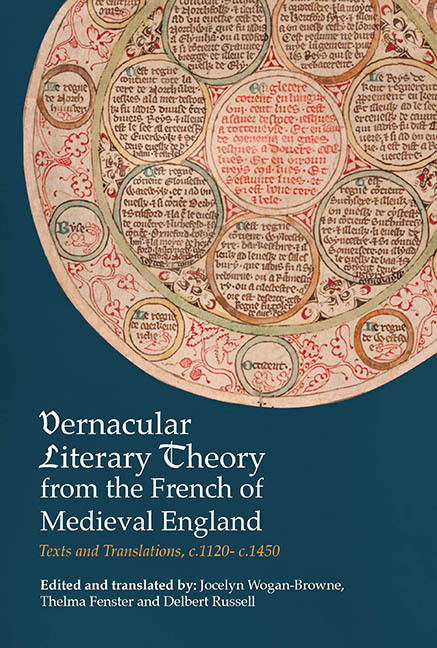 Vernacular Literary Theory from the French of Medieval England
Vernacular Literary Theory from the French of Medieval England Book contents
- Frontmatter
- Dedication
- Contents
- List of Maps and Illustrations
- Preface
- Abbreviations
- Map
- General Introduction
- Establishment of Texts and Translations and Conventions Used
- Part I Faus franceis and dreit engleis: On Language
- Part II Si sa dame ne li aidast: Authorship and the Patron
- Part III Primes dirrum la dreyte fei: The Conduct of Reading, Hearing and Seeing
- Part IV Ki veult oïr: Forming Audiences and Creating Textual Communities
- Part V Si come en latyn trovay escrit: The Lineage of the Text
- Postlude. Honneurs publiées … en divers royaumes
- Part VI Essays and Resources
- Timeline
- Glossary
- Bibliography
- General Index
- Index of Manuscripts
Establishment of Texts and Translations and Conventions Used
Published online by Cambridge University Press: 25 October 2017
- Frontmatter
- Dedication
- Contents
- List of Maps and Illustrations
- Preface
- Abbreviations
- Map
- General Introduction
- Establishment of Texts and Translations and Conventions Used
- Part I Faus franceis and dreit engleis: On Language
- Part II Si sa dame ne li aidast: Authorship and the Patron
- Part III Primes dirrum la dreyte fei: The Conduct of Reading, Hearing and Seeing
- Part IV Ki veult oïr: Forming Audiences and Creating Textual Communities
- Part V Si come en latyn trovay escrit: The Lineage of the Text
- Postlude. Honneurs publiées … en divers royaumes
- Part VI Essays and Resources
- Timeline
- Glossary
- Bibliography
- General Index
- Index of Manuscripts
Summary
All the selections are newly edited, each from a single manuscript. In a few cases the texts given here have not been previously edited; others have been edited during the life of this project. Some have been available only in editions dating from the late-nineteenth-century archival explorations. In cases where a modern printed edition exists, we have often chosen a different manuscript from the published one in order to bring out some aspect of codicological interest, e.g., what the manuscript selection of texts or its mise-en-page may suggest about the text's relations with its audiences. We have sometimes left aside the ‘best text’ manuscript, especially if a modern edition is available, in favour of a manuscript traditionally thought of as a ‘Middle English’ manuscript.
Scribal word division, punctuation and paragraphing are modernised. Editorially supplied letters or words are signalled with square brackets. Where we are editing from a single manuscript text with an already published edition, variants in readings are given in the notes, as are emendations that we have introduced. Scriptural quotations are normally identified in notes to texts where they are not identified in the texts themselves. Citations are from the Vulgate version.
We normalise i/j, u/v to modern French spelling. We add modern diacritics: the cedilla when c precedes a, o, or u; an acute accent on é when it is a stressed vowel in the final syllable of polysyllabic words (this includes aprés, to distinguish it from adj., apres (=Mod.Fr. âpres), and past participles in és, or ét (but not –ez, or fem. –ee, –ees). We also use the acute accent in monosyllables where meaning may not be clear: dé = des (and Dé=Dieu), lé = les, and pués = puis (not 2 pres, pouvoir). We retain Anglo-Norman titles where possible, but use modern French titles where these have become standard in the absence of medieval titles. We use the conventional name ‘Marie de France’, though there is no certainty that the works ascribed to this figure are all by the same woman.
- Type
- Chapter
- Information
- Vernacular Literary Theory from the French of Medieval EnglandTexts and Translations, c.1120- c.1450, pp. 7 - 8Publisher: Boydell & BrewerPrint publication year: 2016


